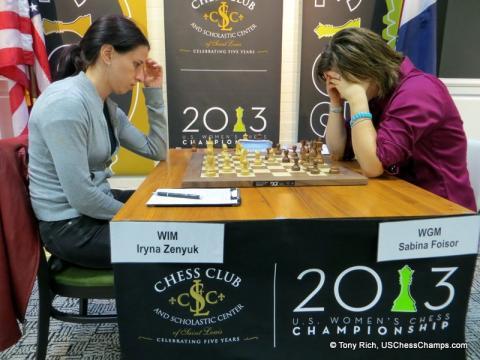
Personal Experience at the U.S. Women's Championship. Part 3.
This week we are wrapping up the overview of my play from the U.S. Women's Championship. The last two articles featured the first six games and today we will look at the key moments from the last three games.
With this article I would like to concentrate not only on the analysis but also the preparation and what kind of advice followed. Speaking of the analysis, one should analyze his/her games after the tournament. Each player should have his/her own routine. As for me, after analyzing with the opponent I briefly look at the computer evaluations after the game, then when I am home I spend about two hours on each game with my coach. Then, if needed, we do additional work later for a specific opening. I also look at the games in depth with an engine. To present all the ideas and analysis here is infeasible due to time and space limitations, therefore I shall only concentrate on the key moments.
In round six I faced WGM Sabina Foisor who had a rough start but seemed to recover and even drew IM Irina Krush. She is a strong practical player with great dynamic sense. However, her opening choices sometimes are questionable. My coach set a task for me to react to any weird setups with central and simple play and not to dive into unnecessary complications. Keep the game simple. For the opening part I managed to achieve this task.
According to the engine, white is much better or has a decisive advantage. What is the most natural move in this position? Of course e5 - the last two moves prepared it and for the Benoni this is the key idea. It involves some calculation but it is easy to see that this move is very strong. It does not let any black pieces out, which is the case if white plays exf5 - then the Ne7 comes out. Generally, if white manages to get the e5 breakthrough, white's position is much better. Let us see some specific lines and reach another critical position.
At this point, I realized that my safe edge disappeared - black will always have enough counterplay against the weak f2-pawn. She can finish development easily with ...Ne5-Nxd3 and ...Bf5. Sure, the kingside is weak but her pieces are active. Here, I came up with a queen sacrifice that temporarily limited black's development. It is objectively correct but with the right play black could have achieved a draw.
This probably was the most stressful game from the whole tournament. After all when was the last time you sacrificed a queen? Probably the best game that I played in this tournament.
My spirits were high after a combative win like this but tomorrow I had to play IM Anna Zatonskih, against whom my score is absolute zero.

We have played about six times and I have yet to score a draw. Having the white pieces is helpful as I don't risk losing out of the opening. We also predicted the Nimzo but had trouble guessing which line of Nimzo. She played Karpov's variation in the e3 Nimzo, following my first-round game against WFM Sarah Chiang, but then deviated at some point. After theoretical opening moves we reached this critical position.
White has two bishops and more space, which is typical for this opening line. However, the c- and d-pawns are hanging and can become weaknesses. One of the main ideas for white is to push them forward with c4-c5 to create a passed pawn before black manages to consolidate and block the pawns. After Qc7 black is already thinking about taking the e5-knight and even further messing up white's pawn structure. Therefore, here I had to decide whether to take on d7 or retreat the bishop. I chose the weaker move. After Nxd7 I preserve the c- and d-pawns and two bishops, maintaining a slight edge. However, after allowing ...Nxe5 the a-, c- and e-pawns become really weak.
After h6 I can either take on f6 or retreat the bishop. The key here is to understand that white's position can become worse very quickly due to all the pawn weaknesses. Unfortunately for me, I didn't realize this in time. Taking the knight is the correct move because then I get rid of the weak e5-pawn and open black's king. Even after that the position remains approximately equal. Retreating the bishop leads to a worse position where black has the very powerful set-up: Rd8-Nd7-Nf8, where the knight defends the kingside and the rooks and queen put pressure on my queenside. Anna played the remaining moves of the game with unbelievable precision and found all the correct plans. As for me I felt that I lacked complete chess understanding after this game.
Either way, after this game I had no chances to fight for the third place but had good chances to get clear fourth place. My last round opponent WGM Anjelina Belakovskaia hasn't played chess professionally for a long time. Recently she came back; she still lacks modern openings but overall is a strong player. We expected the Trompowsky Attack as an opening and my goal once again was to play simple but solid chess. The 2...d5 line fits this purpose very well as the resulting positions are of a maneuvering type with black having clear plans. In this game I managed to keep the game out of complications better than in the game against Foisor.
We have reached a key position. Normally, black wants to transfer the knight to e4 but in the given position white put some strain on the kingside and I wanted to release it somehow. Playing ...c6,...b6 is one plan and ...c5 is another one. I think ...c5 is stronger because with two bishops one should keep the position open. Hence, ...Nb6 first to attack the bishop then ...Be6 with tempo and ...Rc8 preparing ...c5. Very simple and natural plan.
I am up a pawn but it is not so easy as this extra pawn is a doubled pawn. My bishop is very strong on d5 but so is her e5-knight. A key element in this position to notice is that there are no open files present. Therefore, the rook is not stronger than the knight and giving up the exchange right away is the right decision. I did it a few moves later which gave Belakovskaia extra resources. My bishop keeps an eye on the a2-pawn and if white ever pushes a3 then she allows the ...b3 push.
In the final position Belakovskaia offered me a draw, and after checking the monitors for the Krush-Baginskaite game (which said that Krush won, meaning that a draw gives me a clear fourth place), I accepted. Of course, it turned out that there was a mistake and that game was still going on. But generally in such a winning position I did not have to take a draw under any circumstances. Black can safely improve the position, while white's pieces are all tangled. Draws like these cost very important rating points and I learned my lesson and hopefully will not make these mistakes in the future.
Overall, shared fourth place was my personal best. I am pretty happy with the result and with my play; in the last year I haven't had a single tournament where I did well. Next year I will shoot for the top three if all things go well. Next week we will go over some of the key moments from the U.S. Championship and then will start a new series.






